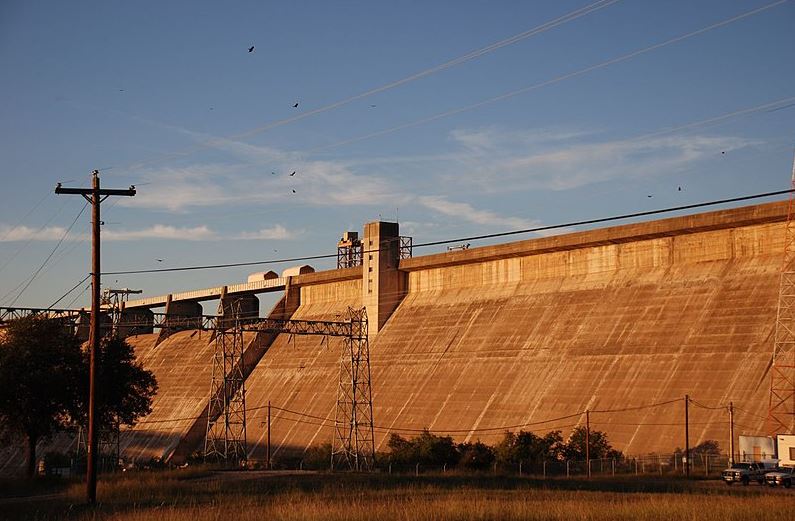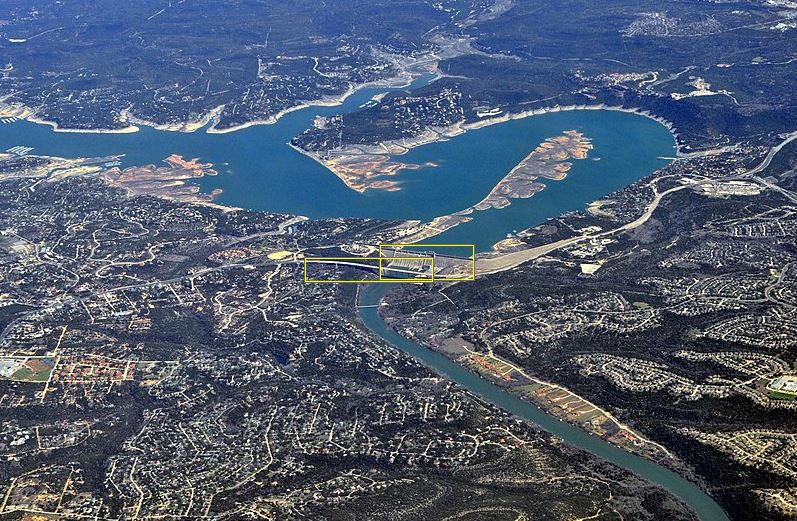The Mansfield Dam in Texas is one impressive dam. Also known as the ‘Marshall Ford Dam,’ it’s among the largest dams in the entire United States. This massive structure has eleven generators that provide power to the state. But that’s not all! It serves other important functions, too, just like many other dams. It acts as a flood control measure for the region, playing a crucial role in Texas’ infrastructure. If you happen to be in the area, make sure to visit Mansfield Dam – it’s a truly beautiful sight.
Introduction to the Biggest Dam in Texas: The Mansfield Dam
Mansfield Dam, located in Marshall Ford on the Colorado River, is a significant structure situated just 13 miles northwest of Austin, Texas. It was in 1941 as part of the Highland Lakes project to provide flood control, electricity, and water storage for Austin. The dam creates Lake Travis, one of Texas’s largest reservoirs.
Initially known as Marshall Ford Dam, the name was later changed to Mansfield Dam in 1941 to pay tribute to the contributions of United States Representative J.J. Mansfield. The reservoir formed behind the dam is called Lake Travis. The Lower Colorado River Authority (LCRA) currently owns and operates the dam.
Impressively, Mansfield Dam stands at a height of 278 feet, spans a length of 7,089 feet, and has a thickness of 213 feet at the base. This concrete gravity dam, featuring embankment wings and saddle dikes, was meticulously designed to fulfill multiple purposes. It serves as a flood control measure, storing a staggering 1.4 cubic kilometers of water. Additionally, the dam harnesses the power of the flowing water to generate hydroelectric power.
In terms of measurements, the spillway elevation reaches 714 feet above mean sea level (MSL). When the water level reaches 681 feet above MSL, the LCRA initiates the opening of the floodgates, effectively managing the flow of water.
History of the Mansfield Dam
At the turn of the 20th century, Austin was on the brink of technological advancements, including the use of dams to harness the power of flooding rains for hydroelectricity. The visionaries, like Senator Lyndon B. Johnson, saw the potential and fought for the construction of seven dams that would eventually form the Highland Lakes in Central Texas.
During the early 1900s, the region experienced frequent and devastating floods. From 1900 to 1913 alone, Austin faced over 17 major floods, resulting in loss of life, destruction of farmlands, and significant damages to communities in Matagorda and Wharton counties. It became evident that measures were needed to control these destructive floods and protect lives and property.
In 1935, Austin faced one of its worst floods, triggering the need for a solution. In December 1936, the United States Department of the Interior authorized the creation of the Lower Colorado River Authority (LCRA) to address the flooding issues in the area. The plan was to construct a “low dam” at the Marshall Ford site, initially at a height of 190 feet. However, another catastrophic flood in July 1938 led to the decision to raise the dam’s height to 265 feet.
Two years after the completion of the first Highland Lakes dam, the Austin Dam on Lake Austin, the Marshall Ford Dam was constructed. On August 25, 1942, it was officially dedicated and later renamed Mansfield Dam in honor of J.J. Mansfield, a determined United States Representative who advocated for its construction.
Senator Lyndon Baines Johnson played a crucial role in securing federal funding for the dam projects. His efforts eventually led to the enactment of the Rural Electrification Act, which became the driving force behind the creation of the Highland Lakes.
These events mark the beginning of Lake Travis and its rich history, shaped by the determination of individuals like Senator Johnson and the commitment to flood control and hydroelectric power in Central Texas.
Fun Facts About the Mansfield Dam
There are four potential “Mansfields” that it was named after
Different sources say different Mansfields to whom the dam was named. Most of them say that the dam was renamed to honor Joseph Jefferson “J.J.” Mansfield, a U.S. Representative who worked for the construction of the dam to be possible.
Some say the dam is named after James Mansfield, the mayor of Austin, Texas, at the time. Others say it was named after Jack Mansfield, an early settler and landowner in Austin, whose log cabin from 1838 can still be found near the dam site. Also, some say that the dam was named after the esteemed chief engineer Robert E. Mansfield who worked on the dam.
However, between all these options, J.J. Mansfield is the most likely origin of the name of the dam, as the sources that mention him are more reputable.
It’s a gravity dam on the Colorado River
The dam, made of concrete with embankment wings and saddle dikes, serves multiple purposes. It’s designed to control floods, store a massive amount of water (1.4 km³ or 369 billion U.S. gallons), and generate hydroelectric power (108 megawatts). The Spillway Elevation is at 714 feet (218 m) above Mean Sea Level (MSL), and the floodgates are opened by the LCRA when the water level reaches 681 feet above MSL. As the lake rises to 681 feet (208 m) above MSL, the discharge capacity exceeds 130,000 cubic feet per second (3,700 m3/s).
It also functions as a power plant
Now, let’s talk about the dam as a power plant. This incredible facility utilizes the force of water to generate electricity using six massive turbines. With a capacity of 190 megawatts, it provides power to more than 200,000 homes. It’s a shining example of renewable energy, showcasing how water can be transformed into electrical power with efficiency and innovation.
It was once the tallest dam in the U.S.
Did you know that the Mansfield Dam in central Texas, situated on Lake Travis, is one of the tallest dams in the United States? It was completed in 1941 as part of a water diversion project for the city of Austin. When it was completed, it held the title of the tallest dam in the country, reaching a height of 278 feet (85 meters).
However, a year after, three dams have immediately surpassed its height – one of which is the Grand Coulee Dam in Washington, which stands at 550 feet (170 meters)!
It has a unique spillway
What makes the Mansfield Dam spillway unique is its use of two “cells” to release water. When the lake level exceeds 681 feet, water flows over the first cell’s crest. If the level continues to rise, water enters the second cell and flows over a higher crest. This ensures controlled water release even during heavy rainfall.
It impounds Lake Travis, one of the largest reservoirs in the state
Lake Travis is a man-made lake located in the Hill Country. The Mansfield Dam impounds the Colorado River and forms Lake Travis. Lake Travis and the Dam had a combined history and was completed in 1941.
Lake Travis proudly holds the title of being one of the largest reservoirs in the entire state of Texas. It attracts countless visitors seeking recreational activities like boating, swimming, and fishing. With a capacity exceeding 1.5 million acre-feet (that’s a whopping 1.9 trillion gallons!), the lake not only provides endless enjoyment but also serves as a crucial water source for Central Texas cities like Austin and San Antonio.
What Would Happen if the Mansfield Dam Breaks?
While highly unlikely, there has been speculation about the potential consequences if Mansfield Dam were to break. It’s important to note that the dam has been functioning safely for over 82 years without any issues. However, in 2018, researchers conducted a study to examine this hypothetical situation.
Their findings were concerning, indicating that if such an event were to occur, Central Austin would experience extensive devastation and a significant loss of life. The outpouring of water could reach a staggering 1.1 million cubic feet per second, and the city would face a wave traveling at speeds of 50 miles per hour. The impact on communities and wildlife downstream of the dam would be severe.
It is crucial to emphasize that experts maintain the probability of such an event happening is exceedingly low. While this scenario sparks curiosity and raises questions, focusing on the long-standing record of the dam’s safe operation is essential.
Wildlife Around Mansfield Dam
The area around Mansfield Dam is home to a variety of wildlife thanks to the Colorado River and Lake Travis. Let’s explore some of the fascinating creatures you can find around the largest dam in Texas.
Bluegill
Bluegills are sunfish with unique characteristics. They have dark olive-green bodies that lighten along the sides, and their bellies are yellowish. During the breeding season, male bluegills sport a reddish coloring, and their cheeks have an iridescent blue hue. These fish have small mouths, deep bodies, and a dark spot at the base of their dorsal fin. Bluegills mainly feed on insects, zooplankton, worms, and snails. They are excellent swimmers and can change direction and even swim backward by adjusting their fin movements. While they are enjoyed pan-fried by many, anglers often use bluegills as bait to catch bigger fish.
Osprey
The diverse fish population in Lake Travis attracts many ospreys. These birds are remarkable hunters with exceptional vision. They can detect underwater objects from the air and catch fish by diving feet first with their razor talons. Sometimes, ospreys fully submerge in the water to grab their prey. They have a high success rate, catching a fish about one out of every four attempts. Ospreys are migratory birds and cover an average of 160,000 miles in their lifetime. They return to the same spot yearly and often reuse their nests. Male and female ospreys renovate their nests by collecting sticks, grasses, and other vegetation before egg laying.
Zebra Mussels
Unfortunately, zebra mussels are an invasive species that have affected the entire state of Texas, including the reservoir of Mansfield Dam. They first appeared in the Great Lakes in the 1980s, likely transported through the ballast water of cargo ships from Europe. Zebra mussels have since spread throughout the Great Lakes and down the Mississippi River. They pose a problem to native ecosystems as they filter out algae that other species rely on and smother native mussels. Additionally, they can clog pipes, damage water intakes, and obstruct power stations. Efforts to remove zebra mussels require time and dedication. It is important to note that possessing or transporting zebra mussels is illegal in Texas.



